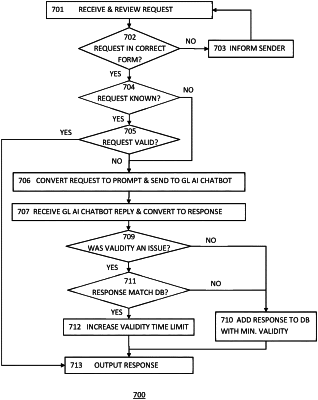| CPC G10L 15/16 (2013.01) [G10L 13/086 (2013.01)] | 18 Claims |

|
1. A method for automatically training an AI request processing system, comprising:
providing a request-response AI chatbot, said request-response chatbot having been implemented using only rules-based computer code;
providing a functional connection to a generative language AI chatbot, said generative language AI chatbot comprising a trained pre-trained attention-based neural network;
receiving, by said request-response chatbot, a request;
checking, by said request-response chatbot, a functionally connected request/response database to ascertain whether said request is a known request;
when said request is determined to be a known request, checking to ascertain whether an associated response is valid;
when said associated response is determined to be both associated with a known request and valid, outputting said associated response;
when said request is determined not to be a known request or said associated response is determined not to be valid:
forming a prompt comprising said request;
sending said prompt to said functionally connected generative language AI chatbot;
receiving a reply from said generative language chatbot;
converting said reply into a new response;
when said associated response was determined to not be valid, further comparing said new response with said associated response, and,
when said new response and said associated response are determined to be essentially the same, setting a new validity time limit having a value greater than a validity time limit previously associated with said response;
when said response and said associated response are determined not to be essentially the same, replacing said associated response with said new response and setting said new validity time limit to a predetermined minimum value;
storing said new response as a valid response on said request/response database; and,
outputting said new response.
|